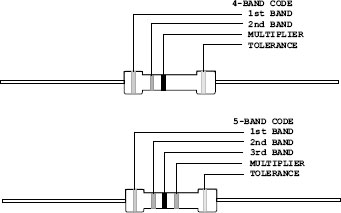 Appendix A – Resistor Color Codes
by Maria P. Canton, Julio Sanchez
Embedded Systems Circuits and Programming
Appendix A – Resistor Color Codes
by Maria P. Canton, Julio Sanchez
Embedded Systems Circuits and Programming
- Cover
- Half Title
- Title Page
- Copyright Page
- Table of Contents
- Preface
- Chapter 1 – Real-Time Computing
- Chapter 2 – Circuit Fundamentals
- Chapter 3 – Logic Gates and Circuit Components
- Chapter 4 – Input and Output Devices
- Chapter 5 – From Circuit Schematics to PCB
- Chapter 6 – Introducing the Microcontroller
- Chapter 7 – Architecture and Instruction Set
- Chapter 8 – Embedded Systems Programming
- 8.1 Assembly versus High-Level Languages
- 8.2 Integrated Development Environment
- 8.3 Simulators and Debuggers
- 8.4 Programmers
- 8.5 Engineering PIC Software
- 8.6 Pseudo In structions
- Chapter 9 – I/O Circuits and Programs
- Chapter 10 – PIC Interrupt System
- 10.1 Interrupts
- 10.2 Interrupt Sources
- 10.3 Developing the Interrupt Handler
- 10.5 Sample Programs
- 10.6 Demonstration Programs
- Chapter 11 – Timers and Counters
- 11.1 Controlling the Time Lapse
- 11.2 Delays Using Timer0
- 11.3 Timer0 as a Counter
- 11.4 Timer0 Programming
- 11.5 Watchdog Timer
- 11.6 Demonstration Programs
- Chapter 12 – LCD Hardware and Programming
- 12.1 Liquid Crystal Display
- 12.2 Interfacing with the HD44780
- 12.3 HD44780 Instruction Set
- 12.4 LCD Programming
- 12.5 Sample Programs
- Chapter 13 – Analog-to-Digital and Real-Time Clocks
- Chapter 14 – Data EEPROM
- Chapter 15 – Stepper Motors
- Chapter 16 – Stepper Motor Circuit Components
- Chapter 17 – Unipolar Motor Circuits and Programs
- 17.1 Stepper Motor Control Circuits
- 17.2 Motor Speed Control
- 17.3 Unipolar Motor Control Circuits
- 17.4 Demonstration Programs
- Chapter 18 – Constant-Voltage Bipolar Motor Controls
- Chapter 19 – Advanced Motor Controls
- Chapter 20 – Communications
- Appendix A – Resistor Color Codes
- Appendix B – Essential Electronics
- Appendix C – Numeric Data
- Appendix D – Character Data
- Appendix E – Digital Arithmetic and Conversions
- Appendix F – Mid-Range Instruction Set
- Appendix G – Printed Circuit Boards
- Appendix H – Additional Code
- Index
The resistor color coding system applies to carbon film, metal oxide film, fusible, precision metal film, and wirewound resistors of the axial lead type. This system is employed when the surface area is not sufficient to print the actual resistance value. Several color codes are used, the most common ones are the 4-band and 5-band codes. In the 4-band code, the first two bands represent the magnitude of the resistance, the third band is a multiplier for this value, and the fourth band encodes the error tolerance. In the 5-band code the first three bands represent the magnitude, the fourth band serves as a multiplier, and the fifth band is the error tolerance.
The color codes for the various bands are as follows:
Color |
Magnitude |
Multiplier |
Tolerance |
Black |
0 |
1 |
|
Brown |
1 |
10 |
1% |
Red |
2 |
100 |
2% |
Orange |
3 |
1K |
|
Yellow |
4 |
10K |
|
Green |
5 |
100K |
0.5% |
Blue |
6 |
1M |
0.25% |
Violet |
7 |
10M |
0.10% |
Grey |
8 |
0.05% |
|
White |
9 |
||
Gold |
0.1 |
5% |
|
Silver |
0.01 |
10% |
To read the resistance value, first determine if it is a 4-band or a 5-band encoding. Then proceed to identify the tolerance band, which is usually either gold or silver. Starting at the opposite end, read the two or three magnitude bands and multiply this value by the multiplier band. For example, a resistor with four color bands, red, orange, brown, and gold, is a 230-Ohm resistor with a 5% error tolerance.
There are several online calculators that allow you to easily find the resistance value. You can locate these calculators by searching for the keywords: resistor color codes.
-
No Comment
